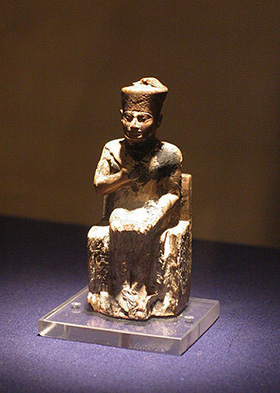Khufu also called Cheops by the Greek was the second king of the Fourth Dynasty of Kmt (ancient Egypt) from around 2589 to 2566. He was one of Kmt’s most significant monarchs.
His great fame is that he built the “Khufu on the Horizon” – the Great Pyramid of Giza – one of the Seven Wonders of the Ancient World. It was the first pyramid to be built at Giza, according to historian and researcher Runoko Rashidi.
Till now, the Pyramid of Khufu is regarded as the purest geometric form in human architecture as well as the single largest building ever constructed by man. Khufu’s vizier, Hemiunu also called Hemon is believed by some to be the architect of the Great Pyramid.
Khufu’s funerary cult unlike others lasted until the 26th dynasty – one of the last native African dynasties of Kmt – almost 2000 years after his death.

Image: Khufu statue at the Egyptian Museum Cairo, Egypt. Photo credit: By Chipdawes – Own work, CC BY 3.0
Khufu ascended the throne after his father Sneferu – first king of ancient Egypt of the 4th dynasty (c. 2575–c. 2465 BCE). His mother was Hetepheres I who was also the mother of three of the era’s notables. She was granddaughter of King Huni and wife to King Sneferu.
Khufu was therefore the second pharaoh of the Fourth Dynasty in the first half of the Old Kingdom period. Although Manetho, a third century BCE historian, suggested a reign of 63 years, others note his reign might have lasted from 23 to 34 years. The only completely preserved portrait of the king is a three-inch high ivory figurine found in a temple ruin of a later period at Abydos in 1903. All other reliefs and statues were found in fragments, and many buildings of Khufu are lost. Everything known about Khufu comes from inscriptions in his necropolis at Giza and later documents. He is believed to have extended the borders of Egypt into the Sinai.
Egypt prospered under the pharaohs of the Fourth Dynasty, which is why they were able to fund their massive building projects. Khufu was succeeded by his son Djedefre, whose reign was quite short, and then by Khafre, another of his sons. Khafre was the builder of the second Giza pyramid.
Khufu probably married four times: to Merityetes, who was buried in one of the three small pyramids beside his own; to a second queen, whose name is unknown; to Henutsen, whose small pyramid is the third of the group; and to Nefert-kau, the eldest of Sneferu’s daughters.

The Great Pyramid has a base measurement of ca. 750 x 750ft (≙ 230.4 x 230.4 m) and today a height of 455.2 ft (138.7 m). Once it had been 481 ft (147 m) high, but the pyramidion and the limestone casing are completely lost due to stone robbery. The lack of the casing allows a full view of the inner core of the pyramid. It was erected in small steps by more or less roughly hewn blocks of dark limestone. The casing was made of nearly white limestone. The outer surface of the casing stones were finely polished so the pyramid shimmered in bright, natural lime-white when new. The pyramidion might have been covered in electrum, but there is no archaeological proof of that. The inner corridors and chambers have walls and ceilings made of polished granite, one of the hardest stones known in Khufu’s time. The mortar used was a mixture of gypsum, sand, pulverized limestone and water.
The original entrance to the pyramid is on the northern side. Inside the pyramid are three chambers: at the top is the burial chamber of the king (the king’s chamber), in the middle is the statue chamber (erroneously called the queen’s chamber), and under the foundation is an unfinished subterranean chamber (underworld chamber).

Khufu’s pyramid was surrounded by an enclosure wall, with each segment 33 ft (10 m) in distance from the pyramid. On the eastern side, directly in front of the pyramid, Khufu’s mortuary temple was built. Its foundation was made of black basalt, a great part of which is still preserved. Pillars and portals were made of red granite and the ceiling stones were of white limestone. Today nothing remains but the foundation. From the mortuary temple a causeway 0.43 miles long once connected to the valley temple. The valley temple was possibly made of the same stones as the mortuary temple, but since even the foundation is not preserved, the original form and size of the valley temple remain unknown.
Greek historian Herodotus in his notes penned: “The making of the pyramid itself there passed a period of 20 years; and the pyramid is square, each side measuring 800 feet, and the height of it is the same. It is built of stone smoothed and fitted together in the most perfect manner, not one of the stones being less than 30 feet in length. This pyramid was made after the manner of steps, which some call ‘rows’ and others ‘bases’.”
Another historian, Diodorus states that the Khufu pyramid was beautifully covered in white, but the top was said to be capped. The pyramid therefore already had no pyramidion anymore. He also thinks that the pyramid was built with ramps, which were removed during the finishing of the limestone shell. Diodorus estimates that the total number of workers was 300,000 and that the building works lasted for 20 years.










